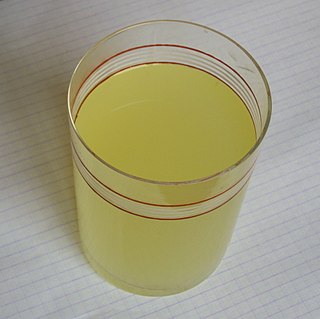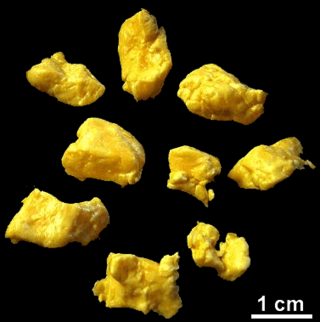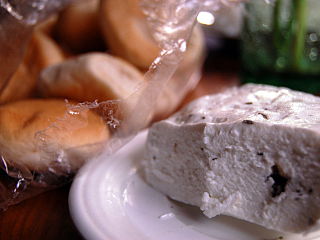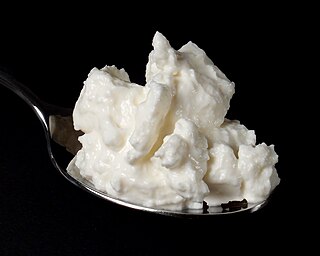
Rennet is a complex set of enzymes produced in the stomachs of ruminant mammals. Chymosin, its key component, is a protease enzyme that curdles the casein in milk. In addition to chymosin, rennet contains other enzymes, such as pepsin and a lipase.

Whey is the liquid remaining after milk has been curdled and strained. It is a byproduct of the manufacturing of cheese or casein and has several commercial uses. Sweet whey is a byproduct resulting from the manufacture of rennet types of hard cheese, like cheddar or Swiss cheese. Acid whey is a byproduct brought out during the making of acid types of dairy products, such as strained yogurt.

Cottage cheese is a curdled milk product with a mild flavour and a creamy, heterogeneous, soupy texture, made from skimmed milk. An essential step in the manufacturing process distinguishing cottage cheese from other fresh cheeses is the addition of a "dressing" to the curd grains, usually cream, which is mainly responsible for the taste of the product. Cottage cheese is not aged.

Mizithra or myzithra is a Greek whey cheese or mixed milk-whey cheese from sheep or goats, or both. It is sold both as a fresh cheese, similar to Italian ricotta, and as a salt-dried grating cheese, similar to Italian ricotta salata. The ratio of milk to whey usually is 7 to 3.

Cheese curds are moist pieces of curdled milk, eaten either alone as a snack, or used in prepared dishes. They are most often consumed throughout the northern United States and Canada. Notably, cheese curds are popular in Quebec, as part of the dish poutine, and in Wisconsin and Minnesota where they can be served breaded and deep fried. Curds are sometimes referred to as "squeaky cheese" or fromage en crottes.

Ricotta is an Italian whey cheese made from sheep, cow, goat, or Italian water buffalo milk whey left over from the production of other cheeses. Like other whey cheeses, it is made by coagulating the proteins that remain after the casein has been used to make cheese, notably albumin and globulin.

Cheesemaking is the craft of making cheese. The production of cheese, like many other food preservation processes, allows the nutritional and economic value of a food material, in this case milk, to be preserved in concentrated form. Cheesemaking allows the production of the cheese with diverse flavors and consistencies.

Paneer, also known as panir, is a fresh acid-set cheese common in the cuisine of the Indian subcontinent made from full-fat buffalo milk or cow milk. It is a non-aged, non-melting soft cheese made by curdling milk with a fruit- or vegetable-derived acid, such as lemon juice.

Acid-set or sour milk cheese is cheese that has been curdled (coagulated) by natural souring, often from lactic acid bacteria, or by the addition of acid. This type of cheese is technologically simple to produce.

Skyr is a traditional Icelandic cultured dairy product. It has the consistency of strained yogurt, but a milder flavor. Skyr can be classified as a fresh sour milk cheese, similar to curd cheese consumed like a yogurt in the Baltic states, the Low Countries and Germany. It has been a part of Icelandic cuisine for centuries.

Junket is a milk-based dessert with a jelly texture, made with sweetened milk and rennet, the digestive enzyme that curdles milk. It is usually set in a mould and served cold.
Crowdie is a type of soft, fresh cheese made from cows' milk, traditionally from Scotland.

Ginger milk curd, also known as ginger-juice milk curd, ginger milk pudding or simply ginger milk, is a Chinese hot dessert originated in Shawan Ancient Town, Panyu District, Guangzhou in the Guangdong Province in southern China. The main ingredients are ginger, milk, and sugar. Water buffalo milk is used in the original recipe.

Clabber is a type of soured milk. It is produced by allowing unpasteurized milk to turn sour (ferment) at a specific humidity and temperature. Over time, the milk thickens or curdles into a yogurt-like consistency with a strong, sour flavor. In Joy of Cooking, "Clabber... is milk that has soured to the stage of a firm curd but not to a separation of the whey."

Tvorog is a European, non-liquid, white fermented milk product, traditional for Eastern, Northern and Central Europe, obtained by fermenting milk with subsequent whey removal. It is officially customary to classify traditionally prepared tvorog according to its fat content. According to GOST RF, tvorog is divided based on physical and chemical indicators into the following categories: fat-free, low-fat, classic and fatty. Also, according to the method of manufacture, such types of tvorog are distinguished as simple, soft, and grained tvorog, which is a type of low-fat tvorog.

Cheese is a dairy product produced in a range of flavors, textures, and forms by coagulation of the milk protein casein. It comprises proteins and fat from milk. During production, milk is usually acidified and either the enzymes of rennet or bacterial enzymes with similar activity are added to cause the casein to coagulate. The solid curds are then separated from the liquid whey and pressed into finished cheese. Some cheeses have aromatic molds on the rind, the outer layer, or throughout.

Kesong puti is a Filipino soft, unaged, white cheese made from unskimmed carabao milk and salt curdled with vinegar, citrus juices, or sometimes rennet. It can also be made with goat or cow milk. It has a mild salty and tart flavor. When an acidifying agent is used, it resembles queso blanco or paneer. When rennet is used, it resembles buffalo mozzarella. Moisture content can also vary, ranging from almost gelatinous to pressed and firm. It can be eaten as is, paired with bread, or used in various dishes in Filipino cuisine. It is usually sold wrapped in banana leaves.

Chongos zamoranos is a Mexican dessert made of curdled milk. It is typically prepared with rennet tablets, milk, sugar and cinnamon. The result is a dish of soft cheese-like consistency on a sweet brown milky syrup. Its origin is attributed to colonial-era convents in the city of Zamora, Michoacán.

Quark or quarg is a type of fresh dairy product made from milk. The milk is soured, usually by adding lactic acid bacteria cultures, and strained once the desired curdling is achieved. It can be classified as fresh acid-set cheese. Traditional quark can be made without rennet, but in modern dairies small quantities of rennet are typically added. It is soft, white and unaged, and usually has no salt added.






















